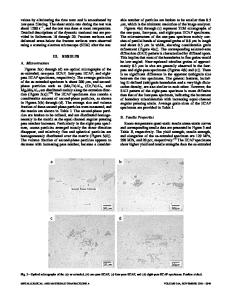Influence of Polycrystalline Structure on Dynamic Strength and Fracture Character of an Aluminum Alloy in Different Weld
- PDF / 1,615,015 Bytes
- 10 Pages / 595 x 794 pts Page_size
- 83 Downloads / 327 Views
INFLUENCE OF POLYCRYSTALLINE STRUCTURE ON DYNAMIC STRENGTH AND FRACTURE CHARACTER OF AN ALUMINUM ALLOY IN DIFFERENT WELDING JOINT ZONES R. R. Balokhonov,1 V. A. Romanova,1 M. V. Sergeev,1 E. S. Emelianova,1 E. M. Dymnich,1 A. V. Zemlianov,2 M. A. Pisarev,2 and E. P. Evtushenko1
UDC 539.3
Plastic strain localization and fracture in the nugget and thermo-mechanically affected zone of a friction stir welded Al6061-T6 alloy are numerically investigated. Dynamic boundary-value problems are solved by the finite-difference method. A procedure for generating ordered and disordered polycrystalline microstructures experimentally observed in different weld zones is developed. A physically-based relaxation constitutive equation is developed to describe dynamic thermomechanical response of the aluminum alloy. Calculations of microstructure tension in polycrystals are performed. The effect of the degree of order and strain rate on the material dynamic strength and fracture are studied. Keywords: friction stir welding, mechanics of nonhomogeneous materials, numerical simulation, polycrystals, plastic strain localization, fracture.
INTRODUCTION It is well known that interfaces play an important role in plastic strain localization and fracture of polycrystalline materials. Structure inhomogeneity is well pronounced in metals with welding joints characterized by distinct interfaces between the nugget and the thermo-mechanically affected zones (TMAZs). A promising method for joining materials is friction stir welding (FSW) demonstrating a number of advantages over traditional welding processes [1, 2]. Among the merits of FSW are – absence of hot cracks and low porosity, possibility of joining dissimilar materials and relatively thick metal sheets using minimal number of operations, and ecological safety. Friction stir welding occurs as follows. A rotating tool of complex geometry is inserted into the butt joint between metal sheets, pressed and moved along the joint of the sheet, ensuring a permanent joint due to mechanical stirring of the material near the sheet edges. This process prevents melting of the stirred material and allows joining the materials that are hard or even impossible to weld without losing their functional properties. Here belong such materials as dispersionhardened aluminum alloys extensively used in automotive, aircraft and other industries due to their high strength-toweight ratio. Despite the extensive introduction of FSW-technologies into current practices, the mechanisms of deformation and fracture of a material in the weld joint zone and neighboring areas are still unclear. There is no unified scientifically-validated theory of FSW-joint formation, especially when it concerns alloys of different grades and dissimilar materials. The issues of strength and durability of the welded structure members are still disputable too. As a result, costly research and experiments on mechanical testing are required in order to optimize welding modes for
1
Institute of Strength Physics and Materials Science of the Si
Data Loading...











